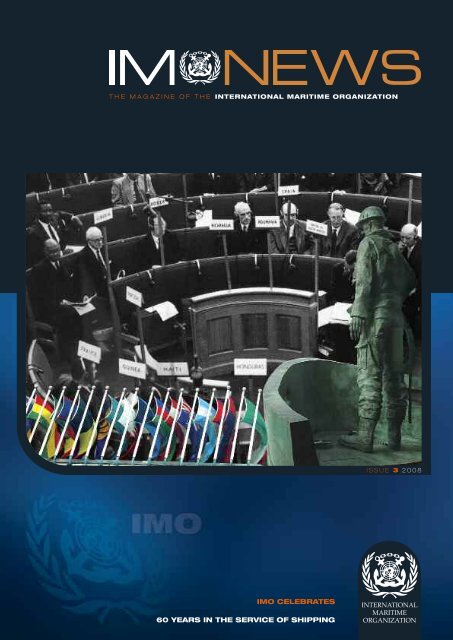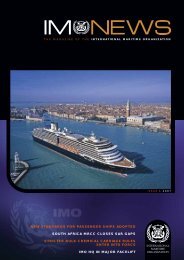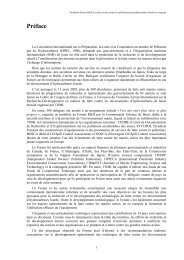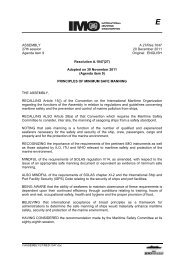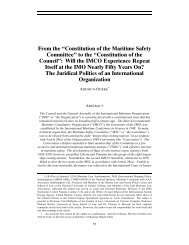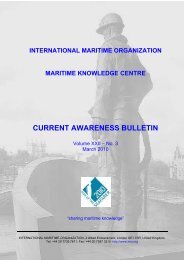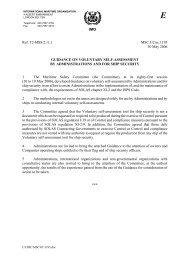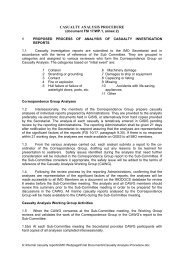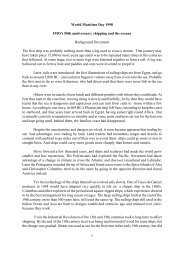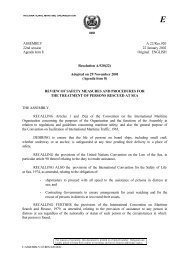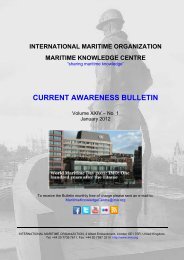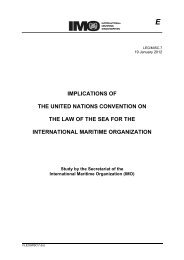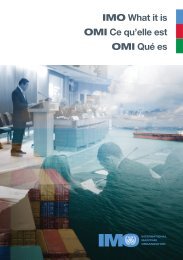IMO News
IMO News
IMO News
You also want an ePaper? Increase the reach of your titles
YUMPU automatically turns print PDFs into web optimized ePapers that Google loves.
T H E M A G A Z I N E O F T H E INTERNATIONAL MARITIME ORGANIZATION<br />
I S S U E 3 . 2 0 0 8<br />
<strong>IMO</strong> CELEBRATES<br />
60 YEARS IN THE SERVICE OF SHIPPING
Feature<br />
World Maritime Day 2008<br />
<strong>IMO</strong>: 60 YEARS IN THE<br />
SERVICE OF SHIPPING<br />
Background paper<br />
Origins<br />
The year 2008 contains a number of key milestones<br />
and anniversaries for <strong>IMO</strong>. March 6 th was the 60 th<br />
anniversary of the adoption of the <strong>IMO</strong> Convention, by<br />
a conference held in Geneva in 1948, under the<br />
auspices of the United Nations; March 17 th was the 50 th<br />
anniversary of that Convention entering into force in<br />
1958; and June saw the 100 th meeting of the <strong>IMO</strong><br />
Council, the executive organ of <strong>IMO</strong>, which is<br />
responsible, under the Assembly, for supervising the<br />
work of the Organization in between successive<br />
sessions of the latter.<br />
<strong>IMO</strong> – originally known as the Inter-governmental<br />
Maritime Consultative Organization, or IMCO – held<br />
its first meeting in London in 1959. The purposes of<br />
the Organization, as summarized by Article 1(a) of its<br />
constitutive Convention, are “to provide machinery for<br />
co-operation among Governments in the field of<br />
governmental regulation and practices relating to<br />
technical matters of all kinds affecting shipping<br />
engaged in international trade; to encourage and<br />
facilitate the general adoption of the highest<br />
practicable standards in matters concerning maritime<br />
safety, efficiency of navigation and prevention and<br />
control of marine pollution from ships”. The<br />
Organization is also empowered to deal with<br />
administrative and legal matters related to these<br />
purposes.<br />
The need for an international agency for shipping<br />
stems from the fact that shipping is perhaps the most<br />
international of all the world’s global industries. The<br />
ownership and management chain surrounding any<br />
particular vessel can embrace many different<br />
countries; it is not unusual to find that the owners,<br />
operators, shippers, charterers, insurers and the<br />
classification society, not to mention the officers and<br />
crew, are all of different nationalities and that none of<br />
these is from the country whose flag flies at the ship’s<br />
stern. And, shipping’s prime physical assets – the ships<br />
themselves – move permanently between countries<br />
and between different jurisdictions; hence the need<br />
for universal standards that can be applied to and<br />
recognized by all.<br />
Shipping is also an inherently dangerous occupation,<br />
with ships having to confront the worst that the<br />
elements can throw at them. Sometimes, disaster<br />
strikes – as witnessed by high-profile incidents of the<br />
type involving ships such as Torrey Canyon, Exxon<br />
Valdez, Estonia, Erika and Prestige.<br />
There is, therefore, an over-arching logic in favour of a<br />
framework of international standards to regulate<br />
shipping. Without internationally recognized and<br />
accepted standards, you might have the ludicrous<br />
situation that a ship leaves country A bound with<br />
cargo for country B, fully compliant with country A’s<br />
requirements for ship design, construction, equipment,<br />
manning and operation, only to find that country B has<br />
its own, different requirements. Clearly there has to be<br />
a common approach, so that ships can ply their trade<br />
around the world and that countries receiving foreign<br />
ships can be confident that, in accepting them, they do<br />
not place their own safety, security and environmental<br />
integrity at an unreasonable risk.<br />
The recognition that the best way of improving safety<br />
at sea is by developing international regulations that<br />
can be followed by all shipping nations pre-dates the<br />
formation of <strong>IMO</strong>. From the mid-19th century onwards<br />
a number of such international treaties were adopted.<br />
One example is the 1863 rules of the road at sea –<br />
known as articles – which were adopted by more than<br />
30 maritime countries.<br />
It was the Titanic disaster of 1912 which prompted<br />
the adoption, in 1914, of the first International<br />
Convention for the Safety of Life at Sea, known then,<br />
as now, as SOLAS, after the United Kingdom had<br />
called an international conference in the wake of the<br />
disaster.<br />
The Convention establishing <strong>IMO</strong> (or the Inter-governmental Maritime<br />
Consultative Organization (IMCO) as it was then known), was<br />
adopted on 6 March 1948, at this conference, held under the<br />
auspices of the United Nations in Geneva<br />
www.imo.org No.3 2008 <strong>IMO</strong> NEWS 27
Feature<br />
The first Assembly of IMCO was held in London on 6 January 1959 with representatives of some 30 countries present. Mr. Ove Nielsen (Denmark) was appointed as the<br />
first Secretary-General and is seen here (centre) taking the oath of office. On the right is the President of the Assembly, Mr. L.C. Audette (Canada)<br />
It was the first convention to lay down international rules<br />
governing the safety of shipping, including construction of<br />
ships, maintaining a 24-hour listening watch for distress alerts,<br />
and making sure enough lifeboats and lifejackets are available<br />
on board for everybody on board. After the adoption of the first<br />
version, subsequent versions were adopted in 1929, 1948 and,<br />
under the auspices of <strong>IMO</strong>, in 1960. Today, albeit much revised<br />
and updated, SOLAS remains the most important of the<br />
international conventions regulating maritime safety. Nearly 160<br />
countries are Parties to the SOLAS Convention and its<br />
provisions apply to almost 99 per cent of the world fleet.<br />
But it was not until the establishment of the United Nations<br />
itself that a permanent international body was created to<br />
promote maritime safety more effectively – and that body is<br />
<strong>IMO</strong>. Since its formation, <strong>IMO</strong>’s main task has been to develop<br />
and maintain a comprehensive regulatory framework for<br />
international shipping. Its mandate was originally limited to<br />
safety-related issues but, subsequently, its remit has expanded<br />
to embrace, among other things, environmental considerations,<br />
legal matters, technical co-operation, issues that affect the<br />
overall efficiency of shipping - such as how to deal with<br />
stowaways or how a cargo manifest should be transmitted to<br />
the authorities ashore; piracy and armed robbery against ships,<br />
and maritime security.<br />
Maritime safety and security<br />
One of the first tasks facing the newly established <strong>IMO</strong> was to<br />
review and revise the 1948 SOLAS Convention. It was in May<br />
1960 that <strong>IMO</strong> convened its first international diplomatic<br />
conference to consider a new SOLAS Convention.<br />
The SOLAS Convention adopted by the 1960 conference (which<br />
entered into force in 1965) covered a wide range of measures<br />
designed to improve the safety of shipping, including<br />
subdivision and stability; machinery and electrical installations;<br />
fire protection, detection and extinction; lifesaving appliances;<br />
radio; the safety of navigation; the carriage of grain; the carriage<br />
of dangerous goods, and nuclear ships. The same conference<br />
also adopted a new set of International Regulations for the<br />
Prevention of Collisions at Sea, to replace earlier regulations of<br />
1948, and adopted 56 resolutions, many of them calling for<br />
action by <strong>IMO</strong> and, in effect, providing the work programme of<br />
the Organization for more than a decade.<br />
The intention was to keep the SOLAS Convention up-to-date by<br />
periodic amendments but, in practice, the amendments<br />
procedure proved to be very slow. It became clear that it would<br />
be impossible to secure the entry into force of amendments<br />
within a reasonable period of time.<br />
As a result, a completely new Convention was adopted in 1974<br />
which included not only the amendments agreed up to that date<br />
but a new amendment procedure – the tacit acceptance<br />
procedure – designed to ensure that changes could be made<br />
within a specified (and acceptably short) period of time.<br />
Instead of requiring that an amendment shall enter into force<br />
after being accepted by, for example, two thirds of the Parties,<br />
the tacit acceptance procedure provides that an amendment<br />
shall enter into force on a specified date unless, before that<br />
date, objections to it are received from an agreed number of<br />
Parties.<br />
As a result, the 1974 Convention has been updated and amended<br />
on numerous occasions and the Convention in force today is<br />
28 <strong>IMO</strong> NEWS No.3 2008 www.imo.org
Feature<br />
IMCO's first home was in Chancery Lane, London. The second was in 22 Berners Street, London (shown here), a building shared with the International Coffee<br />
Organization from the early 1960s to 1970<br />
sometimes referred to as ‘SOLAS, 1974, as amended’. Several<br />
new chapters have subsequently been added, for example, on<br />
Management for the Safe Operation of Ships; Safety Measures<br />
for High-speed Craft; Special measures to enhance maritime<br />
safety; special measures to enhance maritime security; and<br />
additional safety measures for bulk carriers.<br />
The 1960 Safety of Life at Sea Conference also recommended<br />
that Governments should adopt a uniform international code for<br />
the transport of dangerous goods by sea, to supplement the<br />
regulations contained in the SOLAS Convention. In this context,<br />
“dangerous goods” includes, among others, explosive,<br />
flammable, toxic, infectious, radioactive and corrosive<br />
substances. It was agreed that the proposed code should cover<br />
such matters as packing, container traffic and stowage, with<br />
particular reference to the segregation of incompatible<br />
substances.<br />
A working group of <strong>IMO</strong>’s Maritime Safety Committee began<br />
preparing the Code in 1961, in close co operation with the<br />
United Nations Committee of Experts on the Transport of<br />
Dangerous Goods, which had established minimum<br />
requirements for the transport of such goods by all modes of<br />
transport. The resultant International Maritime Dangerous<br />
Goods Code was adopted by <strong>IMO</strong> in 1965. Since then, it has<br />
undergone many changes, both in appearance and content, to<br />
keep pace with the ever changing needs of industry.<br />
Although the IMDG Code was originally recommendatory, it<br />
quickly became the accepted standard for the shipping industry.<br />
Eventually, amendments to SOLAS, adopted in May 2002, made<br />
the IMDG Code mandatory from 1 January 2004.<br />
Anyone familiar with ships will be familiar with the markings<br />
painted on the side of ships’ hulls to indicate how deeply a ship<br />
has been loaded. It has long been recognized that limits on the<br />
draught to which a ship may be loaded make a significant<br />
contribution to its safety. The first International Convention on<br />
Load Lines was adopted in 1930. In 1966, <strong>IMO</strong> adopted a new<br />
Load Lines Convention, in which provisions are made to<br />
determine the freeboard of ships by subdivision and damage<br />
stability calculations.<br />
It also takes into account the potential hazards present in<br />
different geographical zones and different seasons and contains<br />
several additional safety measures concerning doors, freeing<br />
ports, hatchways and other items. The main purpose of these<br />
measures is to ensure the watertight integrity of ships’ hulls<br />
below the freeboard deck. And, it requires the familiar marking<br />
of all assigned load lines and the deck line on each side of the<br />
ship.<br />
The International Convention on Load Lines entered into force<br />
in 1968 and has subsequently been amended on several<br />
occasions.<br />
In a similar vein, at the time of <strong>IMO</strong>’s formation, several systems<br />
of tonnage measurement for ships had been developed over the<br />
years, but none had become universally recognized. <strong>IMO</strong> began<br />
work on this subject soon after coming into being and, in 1969,<br />
the first ever International Convention on Tonnage was adopted.<br />
www.imo.org No.3 2008 <strong>IMO</strong> NEWS 29
Feature<br />
IMCO then moved to 101 Piccadilly, London in 1970. This photograph shows limousines outside the building, waiting to collect Mr. U. Thant (Secretary-General of the<br />
United Nations, 1961-1971) who was on an official visit. 101 Piccadilly now houses the Japanese Embassy<br />
It is an indication of the complexity of this subject that the<br />
Convention, which had a very high requirement for entry into<br />
force (25 States with not less than 65 per cent of the world's<br />
gross tonnage of merchant shipping) did not receive the<br />
required number of acceptances until mid-1980. It entered into<br />
force in 1982.<br />
When <strong>IMO</strong> was formed, the now-familiar bulk carrier, often<br />
described as the “workhorse” of the world fleet, was a relatively<br />
new ship type. These ubiquitous vessels can carry a variety of<br />
different cargoes but commodities such as coal, grains and<br />
mineral ores account for the largest proportion of bulk carrier<br />
cargoes. Although relatively unsophisticated, these are<br />
nevertheless highly efficient ships which also embody inherent<br />
risks and dangers if not designed, built and operated to the<br />
highest standards.<br />
In 1965, therefore, <strong>IMO</strong> adopted the international Code of Safe<br />
Practice for Solid Bulk Cargoes (BC Code) and this has been<br />
updated at regular intervals ever since.<br />
In the early 1990s, there was a spate of bulk carrier casualties<br />
which, because of the often dense nature of the cargoes carried<br />
by such vessels, were frequently characterized by rapid sinking<br />
and a high mortality rate among the crews involved in such<br />
incidents. In November 1997, therefore, <strong>IMO</strong> adopted a special<br />
chapter of the SOLAS Convention on bulk carrier safety<br />
(chapter XII), covering such topics as damage stability,<br />
structural strength, surveys and loading. At the same time, a<br />
Code of Practice for the safe unloading and loading of bulk<br />
carriers (the BLU Code) was also adopted.<br />
Following the 1998 publication of the report into the sinking of<br />
the bulk carrier Derbyshire, <strong>IMO</strong> initiated a further review of<br />
bulk carrier safety. In 2002, amendments to SOLAS and the 1988<br />
Load Lines Protocol were adopted and a number of further<br />
recommendations to improve bulk carrier safety were agreed. In<br />
December 2004, <strong>IMO</strong> adopted a new text for SOLAS chapter XII,<br />
incorporating revisions to some regulations and new<br />
requirements relating to double-side-skin bulk carriers. These<br />
amendments entered into force on 1 July 2006.<br />
In 1971 <strong>IMO</strong> adopted the first of several measures designed to<br />
address specifically the question of safety aboard passenger<br />
vessels. In this case the Special Trade Passenger Ships<br />
Agreement was adopted to safeguard ships and passengers<br />
engaged in “pilgrim” trade, and this came into force three years<br />
later. A Protocol to this agreement, adopted in 1973, came into<br />
force in 1977.<br />
Passenger ships in operation today are subject to a vast array of<br />
regulations and standards covering every aspect of ship<br />
construction and operation. Indeed, passenger ships – usually<br />
defined as a ship carrying more than 12 passengers – on<br />
international voyages must comply with all relevant <strong>IMO</strong><br />
regulations, including those in the SOLAS and Load Lines<br />
Conventions.<br />
In addition, a number of incidents over the years have led to<br />
improvements in safety requirements, including those relating<br />
to fire safety measures – such as escape routes and fire<br />
30 <strong>IMO</strong> NEWS No.3 2008 www.imo.org
Feature<br />
<strong>IMO</strong> moved to new Headquarters (opened in 1982) built on the site of this warehouse, formerly owned by the newspaper and magazine retail chain WH Smith<br />
protection systems for the large atrium typical of cruise ships –<br />
and life-saving appliances and arrangements.<br />
The partial capsize of the roll-on, roll-off (ro-ro) ferry Herald of<br />
Free Enterprise in 1987, for example, led to a series of<br />
amendments to SOLAS designed to prevent such an accident<br />
recurring. These included requirements for open-door<br />
indicators, and monitors to detect the presence of water, vehicle<br />
movement, fire and unauthorized passenger access. Subsequent<br />
amendments, adopted in the late 1980s and early 1990s, dealt<br />
with a variety of aspects, such as emergency lighting, damaged<br />
and intact stability, locking of cargo loading doors, surveys,<br />
openings in watertight bulkheads, fire safety and a number of<br />
other important considerations.<br />
Towards the end of the 20th century, a new breed of giant<br />
passenger vessel was beginning to find its way from naval<br />
architects’ drawing boards and into service with many of the<br />
leading operators. These massive ships were the size of small<br />
villages, often with several thousand passengers, crew and hotel<br />
staff on board. While there was no doubt that such ships were<br />
being built, designed and operated in compliance with<br />
applicable <strong>IMO</strong> standards, the time had come for <strong>IMO</strong> to<br />
undertake a holistic consideration of safety issues pertaining to<br />
passenger ships. As a result, a comprehensive review of<br />
passenger ship safety was initiated in 2000, with the aim of<br />
assessing whether the existing regulations were still adequate.<br />
It was agreed that future large passenger ships should be<br />
designed for improved survivability based on the time-honoured<br />
principle that “a ship is its own best lifeboat”. This approach<br />
envisages that passengers and crew should normally be able to<br />
evacuate to a safe haven on board and stay there. In addition, it<br />
envisages that a ship should always be able to proceed to port at<br />
a minimum safe speed.<br />
In 2006, <strong>IMO</strong> adopted a package of amendments to SOLAS,<br />
based on a guiding philosophy that the regulatory framework<br />
should place more emphasis on the prevention of a casualty<br />
from occurring in the first place. The amendments include new<br />
concepts such as the incorporation of criteria for the amount of<br />
damage a ship is able to withstand, according to the design<br />
basis, and still safely return to port. They also provide<br />
regulatory flexibility, so that ship designers can meet any safety<br />
challenges the future may bring.<br />
A convention adopted by <strong>IMO</strong> in 1972 dealt with the subject of<br />
containers. These had, by then, become an important feature of<br />
international maritime trade, and the Convention was designed<br />
not only to facilitate this trade, by providing uniform<br />
international regulations, but also to maintain a high level of<br />
safety in the carriage of containers by setting out generally<br />
acceptable test procedures and related strength requirements.<br />
The Convention entered into force in 1977.<br />
The safety of fishing vessels has been a matter of concern to<br />
<strong>IMO</strong> since the Organization’s inception, but the differences in<br />
design and operation between fishing vessels and other types of<br />
ship have proved to be an obstacle to their inclusion in many of<br />
the conventions adopted by <strong>IMO</strong>, which cannot be made<br />
applicable to fishing vessels. Besides, the technical<br />
www.imo.org No.3 2008 <strong>IMO</strong> NEWS 31
Feature<br />
Mr. Ove Nielsen (Denmark), the first Secretary-General from 1959 to 1961<br />
specifications of fishing vessels depend on the areas in which<br />
they operate and many other local factors, making the adoption<br />
of international regulations relating to their safety extremely<br />
complex.<br />
Thus, despite fishing being one of the world’s oldest industries,<br />
it was not until 1977 that the first international convention<br />
dealing with the safety of fishing vessels – the Torremolinos<br />
Convention – was finally adopted.<br />
For various reasons, the Torremolinos Convention did not<br />
secure sufficient acceptances to enter into force and, by the<br />
early 1990s, it was clear that, even if it did, it would be<br />
technically out of date. As a result, in 1993, <strong>IMO</strong> adopted a<br />
Protocol to the Convention which removed some of the<br />
provisions that had caused difficulties in the parent treaty and<br />
also brought it up to date technically.<br />
Nevertheless, even this Protocol has yet to enter into force, as<br />
has the 1995 International Convention on Standards of Training,<br />
Certification and Watchkeeping for Fishing Vessel Personnel.<br />
The fact remains that the fishing sector, which reportedly<br />
suffers around 24,000 human losses annually, is still lacking the<br />
international mandatory safety regime that these measures<br />
would provide.<br />
To try and address the issue, <strong>IMO</strong> has engaged in a variety of<br />
technical co-operation activities on fishing vessel safety –<br />
including regional seminars to raise awareness of the problems.<br />
Moreover, in collaboration with the Food and Agriculture<br />
Organization (FAO) and the International Labour Organization<br />
(ILO), <strong>IMO</strong> developed the revised Code of Safety for Fishermen<br />
and Fishing Vessels, 2005, and Voluntary Guidelines for the<br />
Design, Construction and Equipment of Small Fishing Vessels,<br />
2005, while the SLF Sub-Committee is developing guidance on<br />
the safety of fishing vessels under 12 metres and the Standards<br />
of Training and Watchkeeping (STW) Sub-Committee is working<br />
on guidance for the training of personnel serving aboard small<br />
fishing vessels – but none of these voluntary measures would<br />
have the impact of a mandatory convention.<br />
By the 1970s, the conventional radio spectrum used by ships to<br />
communicate with each other and with the shore was becoming<br />
increasingly congested and it was physically impossible to<br />
increase the number of wavelengths available. But these<br />
difficulties could be overcome by using satellites, in space. In<br />
1976, therefore, <strong>IMO</strong> adopted an international convention to<br />
establish the International Mobile Satellite Organization<br />
(IMSO) 1 , which came into force in 1979.<br />
Quite apart from addressing the problem of congestion,<br />
satellites have been of great benefit in commercial and other<br />
aspects of ship operation, but their greatest advantage is in<br />
safety, for improved communications enable distress messages<br />
to be transmitted and received much more effectively than<br />
terrestrial methods.<br />
Ship distress and safety communication entered a new era on<br />
1 February 1999 with the full implementation of the Global<br />
Maritime Distress and Safety System (GMDSS) - an integrated<br />
communication system using both satellite and terrestrial radiocommunication<br />
to ensure that, no matter where a ship may be<br />
in distress, its distress call can be received by the appropriate<br />
authorities and help can be dispatched.<br />
1<br />
The original body established by the Convention was the International Maritime Satellite Organization (INMARSAT), which later split into the private sector<br />
company, Inmarsat, and the International Mobile Satellite Organization (IMSO), the intergovernmental organization that oversees certain public satellite safety and<br />
security communication services provided via the Inmarsat satellites (and by any other future providers of satellite services).<br />
32 <strong>IMO</strong> NEWS No.3 2008 www.imo.org
Feature<br />
Mr. William Graham (United Kingdom) served as Secretary-General from 1961 to 1963 (seen here with the IMCO Librarian, Miss Armstrong)<br />
The GMDSS was developed by <strong>IMO</strong> in close co-operation with<br />
the International Telecommunication Union (ITU) and other<br />
international organizations, notably the World Meteorological<br />
Organization (WMO), the International Hydrographic<br />
Organization (IHO) and the COSPAS-SARSAT partners.<br />
Under the GMDSS, ships have to carry specified satellite and<br />
radio-communication equipment for sending and receiving<br />
distress alerts and maritime safety information, and for general<br />
communication. The GMDSS requirements are contained in<br />
Chapter IV of SOLAS and were adopted in 1988. They entered<br />
into force on 1 February 1992 but provided for a phase-in period<br />
before the final implementation date of 1 February 1999.<br />
Closely linked to the development of the GMDSS was the<br />
adoption, in April 1979, of the International Convention on<br />
Maritime Search and Rescue. As its name implies, this<br />
Convention was designed to improve arrangements for carrying<br />
out search and rescue operations following accidents at sea.<br />
Although many countries had established their own plans for<br />
such emergencies, this was the first time that international<br />
procedures were adopted. It entered into force in 1985, was<br />
revised in 1988 and again in 2004.<br />
Concurrently with the revision of the SAR Convention, the <strong>IMO</strong><br />
and the International Civil Aviation Organization (ICAO) jointly<br />
developed the International Aeronautical and Maritime Search<br />
and Rescue (IAMSAR) Manual, which revised and replaced the<br />
<strong>IMO</strong> Merchant Ship Search and Rescue Manual (MERSAR), first<br />
published in 1971, and the <strong>IMO</strong> Search and Rescue Manual<br />
(<strong>IMO</strong>SAR), first published in 1978. It is designed primarily to aid<br />
the master of any vessel who might be called upon to conduct<br />
SAR operations at sea for persons in distress, and has been<br />
revised and updated on a number of occasions.<br />
<strong>IMO</strong> has always paid great attention to the improvement of<br />
navigational safety and, since 1959, a whole series of measures<br />
have been introduced, in the form of conventions,<br />
recommendations and other instruments. There are two<br />
conventions that are particularly relevant to navigation. These<br />
are the SOLAS Convention, which has an entire chapter<br />
(chapter V) devoted to navigational safety, and the Convention<br />
on the International Regulations for Preventing Collisions at<br />
Sea, 1972 (COLREGs).<br />
In its many regulations, chapter V of SOLAS includes carriage<br />
requirements for shipboard navigational equipment, such as<br />
compasses (magnetic and gyro), radar, automatic radar plotting<br />
aids, echo sounders, devices to indicate speed and distance,<br />
devices to indicate rudder angle, propeller revolutions, rate-ofturn<br />
indicators and radio-direction finders. It also identifies<br />
certain navigation safety services which should be provided by<br />
Contracting Governments such as the maintenance of<br />
meteorological services for ships; the ice patrol service;<br />
routeing of ships; and the maintenance of search and rescue<br />
services. Such equipment must comply with the performance<br />
standards set out in various <strong>IMO</strong> Assembly resolutions.<br />
Chapter V has been amended and updated many times, and in<br />
December 2000, a fully revised version was adopted,<br />
incorporating several new requirements, which entered into<br />
force in 2002. Among other things, this latest version made<br />
mandatory the carriage of voyage data recorders (VDRs) and<br />
www.imo.org No.3 2008 <strong>IMO</strong> NEWS 33
Feature<br />
Mr. Jean Roullier (France), Secretary-General from 1964 to 1967 Mr. Colin Goad (United Kingdom), Secretary-General from 1968 to 1973<br />
automatic ship identification systems (AIS) aboard certain<br />
ships. Further amendments have been adopted since then,<br />
including the introduction of Long Range Identification and<br />
Tracking (LRIT) systems for ships, adopted in 2006.<br />
Besides Conventions, <strong>IMO</strong> has also issued a series of<br />
resolutions and codes, including guidelines on navigation issues<br />
and performance standards for shipborne navigational and<br />
radio-communication equipment. Some are simply<br />
recommendations - though such is their wide acceptance that<br />
they effectively mark international policy - while others are<br />
referred to by relevant Regulations of specific Conventions,<br />
thereby giving them the same weight as the Convention<br />
regulations themselves.<br />
The human element in shipping is a complex, multi-dimensional<br />
issue that affects maritime safety, security and marine<br />
environmental protection, involving the entire spectrum of<br />
human activities performed by ships’ crews, shore based<br />
management, regulatory bodies and others. <strong>IMO</strong>’s concern with<br />
the human element is long established and has been intensified<br />
in recent years.<br />
In 1978, <strong>IMO</strong> adopted the first Convention on Standards of<br />
Training, Certification and Watchkeeping for Seafarers (STCW).<br />
This Convention entered into force in 1984. The 1978 STCW<br />
Convention was the first to establish basic requirements on<br />
training, certification and watchkeeping for seafarers on an<br />
international level. Previously, standards for officers and ratings<br />
were established by individual Governments, usually without<br />
reference to practices in other countries. As a result, standards<br />
and procedures varied widely.<br />
The STCW Convention was revised in 1995 to bring it fully up to<br />
date. The revised Convention placed the emphasis firmly on<br />
demonstrating competence, rather than simply undertaking<br />
training. Its most radical feature was that it gave <strong>IMO</strong> some<br />
responsibility for ensuring that its requirements were met.<br />
Parties to the Convention were required to submit information<br />
to <strong>IMO</strong> concerning their training, certification and other<br />
procedures so that their ability to implement the Convention<br />
could be assessed. The so called “White List” of Parties deemed<br />
to be giving full and complete effect to the Convention was first<br />
published in 2000 and is regularly updated. This was the first<br />
time that <strong>IMO</strong> had ever been given such authority over<br />
Governments and was seen, not only as recognition of the<br />
importance of enforcing standards internationally, but also of<br />
<strong>IMO</strong>’s own ability to ensure that this is done.<br />
The STCW Convention and Code is currently undergoing<br />
another major review, considering what amendments or new<br />
regulations are needed in order to ensure that ensure that the<br />
Convention meets the new challenges facing the shipping<br />
industry including, but not limited to, rapid technological<br />
advances today and in years to come. It is intended to hold a<br />
conference in 2010 to consider the revised STCW Convention<br />
and Code for adoption.<br />
In 1994 a new chapter added to the SOLAS Convention made<br />
mandatory the International Safety Management (ISM) Code,<br />
designed to make safety a first priority for shipping company<br />
management. It became obligatory for passenger ships, tankers,<br />
bulk carriers and some other ships on 1 July 1998 and for all<br />
34 <strong>IMO</strong> NEWS No.3 2008 www.imo.org
Feature<br />
Mr. Chandrika Prasad Srivastava (India), Secretary-General from 1974 to 1989.<br />
During this period, in 1982, IMCO became the International Maritime<br />
Organization (<strong>IMO</strong>)<br />
ships in 2002.<br />
In 1997, <strong>IMO</strong> adopted a resolution setting out its vision,<br />
principles and goals for the human element (revised and<br />
updated in 2003) and, in 1999, an Assembly resolution agreed to<br />
“switch the emphasis onto people” in the work of the<br />
Organization.<br />
Moving on to other human element aspects of <strong>IMO</strong>’s work,<br />
fatigue has been increasingly identified as a key factor in many<br />
shipping accidents. A resolution on fatigue factors in manning<br />
and safety was adopted by <strong>IMO</strong> in 1993, drawing the attention of<br />
all parties involved in ship operations to the factors which can<br />
contribute to fatigue and encouraging them to take them into<br />
account when making decisions on ship operations. <strong>IMO</strong> has<br />
also developed practical guidance to promote better<br />
understanding and management of fatigue.<br />
In 1999, <strong>IMO</strong> adopted a resolution on principles of safe<br />
manning. This noted, among other things, that the ability of<br />
seafarers to maintain observance of the requirements is also<br />
dependent upon conditions relating to training, hours of work<br />
and rest, occupational safety, health and hygiene and the proper<br />
provision of food.<br />
<strong>IMO</strong> has also combined with the International Labour<br />
Organization to develop guidelines on Seafarers' Hours of Work<br />
or Rest, designed to help Administrations, shipowners and<br />
seafarers meet their obligations under the ILO Convention on<br />
Seafarers’ Hours of Work and the Manning of Ships and the<br />
STCW Convention.<br />
Mr. William A. O'Neil (Canada), Secretary-General from 1990 to 2003<br />
Maritime security issues first came to prominence on the <strong>IMO</strong><br />
agenda following the hijacking of the Italian cruise ship Achille<br />
Lauro, in October 1985. The following year, the Organization<br />
issued guidance on measures to prevent unlawful acts against<br />
passengers and crew on board ships.<br />
In March 1988, the Convention for the Suppression of Unlawful<br />
Acts against the Safety of Maritime Navigation (the SUA<br />
Convention) was adopted, with a protocol extending its<br />
requirements to unlawful acts against fixed platforms located<br />
on the continental shelf. Both were updated and revised in 2005.<br />
Recently, in the light of terrorist atrocities around the world,<br />
several of which have been aimed at transport infrastructures,<br />
<strong>IMO</strong> adopted a comprehensive set of maritime security<br />
measures in 2002, which came into force in July 2004.<br />
The most important and far reaching of these is the<br />
International Ship and Port Facility (ISPS) Code. Among its<br />
requirements are that Governments should undertake risk<br />
assessments to establish the level of security threat in their<br />
ports, that both ships and ports should appoint dedicated<br />
security officers and have formal security plans drawn up and<br />
approved by their Governments.<br />
<strong>IMO</strong> has adopted other maritime security instruments, including<br />
guidelines for administrations and the shipping industry on<br />
combating acts of piracy and armed robbery against ships;<br />
recommendations on security measures for passenger ferries on<br />
international voyages shorter than 24 hours, and on security<br />
measures for ports; guidelines on the allocation of<br />
responsibilities to seek the successful resolution of stowaway<br />
cases; and guidelines for the prevention and suppression of the<br />
smuggling of drugs, psychotropic substances and precursor<br />
www.imo.org No.3 2008 <strong>IMO</strong> NEWS 35
Feature<br />
Mr. Efthimios E. Mitropoulos (Greece), Secretary-General from 2004 to present<br />
chemicals on ships engaged in international maritime traffic.<br />
In 2005, the number of reported attacks on ships off the coast of<br />
Somalia prompted <strong>IMO</strong> to adopt a resolution bringing the matter<br />
to the attention of the UN Security Council. This action resulted<br />
in a UN Security Council Presidential Statement, issued on 15<br />
March 2006, encouraging UN Member States with naval vessels<br />
and military aircraft operating in international waters and<br />
airspace adjacent to the coast of Somalia to be vigilant for<br />
piracy incidents and to take appropriate action to protect<br />
merchant shipping. In 2007 <strong>IMO</strong> adopted a new resolution on<br />
the same subject, which appealed directly to the Transitional<br />
Federal Government (TFG) of Somalia. requesting it, among<br />
other things, to advise the UN Security Council that it consents<br />
to warships or military aircraft entering its territorial sea when<br />
engaging in operations against pirates or suspected pirates and<br />
armed robbers.<br />
In June 2008, the United Nations Security Council adopted<br />
resolution 1816 (2008), under which the Security Council<br />
decided that, following receipt of a letter from Somalia to the<br />
President of the UN Security Council giving the consent of<br />
Somalia's Transitional Federal Government (TFG), States cooperating<br />
with the TFG would be allowed, for a period of six<br />
months, to enter the country's territorial waters and use "all<br />
necessary means" to repress acts of piracy and armed robbery<br />
at sea, in a manner consistent with relevant provisions of<br />
international law.<br />
Protecting the marine environment<br />
When the <strong>IMO</strong> Convention was adopted in 1948, marine<br />
pollution was regarded as little more than a local problem.<br />
Some areas, notably those near ports and on major shipping<br />
routes, had experienced occasional oil pollution, but it was not<br />
regarded as a matter of international concern. But, by the 1950s,<br />
world trade was growing and oil pollution was increasing. The<br />
International Convention for the Prevention of Pollution of the<br />
Sea by Oil, 1954 (OILPOL 1954) was one positive outcome of<br />
such concern.<br />
<strong>IMO</strong> became operational in 1959, just before the big boom in<br />
international oil trade. Within less than two decades, the world<br />
tanker fleet had increased in tonnage by ten times and tankers<br />
themselves had grown in size by the same amount: in the late<br />
1950s, tankers averaged around 30,000 dwt; by the late 1970s,<br />
several had been built of over 500,000 dwt.<br />
One result of this was an alarming increase in pollution of the<br />
seas, especially oil pollution, which was caused not simply by<br />
tanker accidents but as a result of routine shipping operations,<br />
such as the cleaning of cargo tanks. It was a normal practice at<br />
the time simply to wash the tanks out with water and then pump<br />
the resulting mixture of oil and water into the sea.<br />
The 1954 OILPOL Convention attempted to curb the effects of<br />
this by prohibiting the dumping of oily wastes within a certain<br />
distance from land and in “special areas” where the danger to<br />
the environment was especially acute. In 1962 the limits were<br />
extended by means of an amendment to the treaty.<br />
But it was the Torrey Canyon disaster of 1967 that focused the<br />
attention of the world on the real danger to the environment<br />
posed by the growth in tanker traffic. The Torrey Canyon ran<br />
aground while entering the English Channel and spilled her<br />
entire cargo of 120,000 tons of crude oil into the sea. This<br />
resulted in the biggest oil pollution incident ever recorded up to<br />
36 <strong>IMO</strong> NEWS No.3 2008 www.imo.org
Feature<br />
Contemporary artist's impression showing front elevation of the new Headquarters building<br />
that time. The incident raised questions about measures to<br />
prevent oil pollution from ships and also exposed a number of<br />
deficiencies in the existing system for providing compensation<br />
following accidents at sea.<br />
<strong>IMO</strong>’s response was swift. A plan of action was drawn up which<br />
resulted in the adoption of a series of conventions on the legal<br />
questions that were raised by the incident.<br />
It was recognized, however, that, although accidental pollution<br />
might be spectacular, operational pollution was the bigger<br />
threat. In 1969, therefore, the 1954 OILPOL Convention was<br />
again amended, this time to introduce a procedure known as<br />
‘load on top’ which had been developed by the oil industry and<br />
had the double advantage of saving oil and reducing pollution.<br />
Under the system, the washings resulting from tank cleaning are<br />
pumped into a special tank. During the voyage back to the<br />
loading terminal the oil and water separate. The water at the<br />
bottom of the tank is pumped overboard and, at the terminal, oil<br />
is pumped on to the oil left in the tank. The amendment entered<br />
into force in 1978.<br />
In 1973, a much more ambitious convention was adopted - the<br />
International Convention for the Prevention of Pollution from<br />
Ships (MARPOL). This Convention attempted to counter<br />
pollution by oil, chemicals, sewage, garbage and other harmful<br />
substances and represented the most determined attempt so far<br />
to deal with vessel-source pollution.<br />
In practice, certain technical problems meant that progress<br />
towards ratifying this Convention was very slow, and a series of<br />
tanker accidents that occurred in the winter of 1976-1977 led to<br />
demands for further action. The result was the convening of the<br />
Conference on Tanker Safety and Pollution Prevention in<br />
February 1978. The measures adopted led to great changes in<br />
tanker design and operations.<br />
The most important of the new measures were incorporated in<br />
the Protocol of 1978 relating to the 1974 Convention on the<br />
Safety of Life at Sea (1978 SOLAS Protocol) and the Protocol of<br />
1978 relating to the 1973 International Convention for the<br />
Prevention of Pollution from Ships (1978 MARPOL Protocol).<br />
The 1978 SOLAS Protocol entered into force in May 1981 and<br />
the 1978 MARPOL Protocol, which in effect absorbed the parent<br />
Convention, entered into force in October 1983, with the<br />
combined instrument now being referred to as the 1973<br />
International Convention for the Prevention of Marine Pollution<br />
from Ships, as modified by the Protocol of 1978 relating thereto,<br />
or MARPOL 73/78.<br />
MARPOL 73/78 greatly limits the amount of oil which may be<br />
discharged into the sea during routine operations and bans it<br />
completely in some areas. It requires Governments to provide<br />
reception facilities for oily wastes (from all ships, not just<br />
tankers) and the Organization has developed guidelines on how<br />
these should be provided and has held seminars and workshops<br />
around the world to provide further technical guidance on<br />
installing them.<br />
The 1978 MARPOL Protocol introduced the concept known as<br />
protective location of segregated ballast tanks. It means that the<br />
ballast tanks (which are empty on the cargo carrying leg of the<br />
voyage and only loaded with water ballast for the return leg) are<br />
positioned where the impact of a collision or grounding is likely<br />
to be greatest. In this way the amount of cargo spilled after<br />
such an accident will be greatly reduced. The subsequent<br />
MARPOL amendments of 1983 ban the carriage of oil in the<br />
www.imo.org No.3 2008 <strong>IMO</strong> NEWS 37
Feature<br />
An architect’s sketch of the terrace on the 4th floor of the building<br />
forepeak tank the ship’s most vulnerable point in the event of a<br />
collision. Operational techniques such as load-on-top, crude-oil<br />
washing and inert gas systems are also enshrined in MARPOL or<br />
SOLAS.<br />
In 1989, the tanker Exxon Valdez went aground on the coast of<br />
Alaska. In terms of oil lost, the resulting oil spill was relatively<br />
small, but it led to demands for action from politicians, press<br />
and the public. In the United States, legislation was introduced<br />
making it mandatory for tankers to be fitted with double hulls<br />
and, in 1992, <strong>IMO</strong> amended MARPOL 73/78 to make mandatory<br />
double hulls or an approved alternative. A phase-in programme<br />
was approved for existing tankers. Amendments to Annex I of<br />
MARPOL, adopted in 2001 following the sinking of the tanker<br />
Erika off the Brittany coast, introduced a new global timetable<br />
for accelerating the phase-out of single-hull oil tankers. This<br />
was subsequently revised again by further amendments,<br />
adopted in 2003, after the sinking of the Prestige.<br />
In 1990, <strong>IMO</strong> adopted the International Convention on Oil<br />
Pollution Preparedness, Response and Co operation (OPRC),<br />
which was designed to introduce a global system for responding<br />
to major oil spills. It entered into force in 1995.<br />
The Convention helps to facilitate international co-operation<br />
and mutual assistance in preparing for and responding to major<br />
oil pollution incidents and encourages States to develop and<br />
maintain adequate capability to deal with oil pollution<br />
emergencies.<br />
In 2000, <strong>IMO</strong> adopted the Protocol on Preparedness, Response<br />
and Co-operation to Pollution Incidents by Hazardous and<br />
Noxious Substances (the OPRC-HNS Protocol) which follows<br />
the principles of the OPRC Convention for hazardous and<br />
noxious substances other than oil. It entered into force in 2007.<br />
The underlying principle in both the Convention and its<br />
Protocol is that of co-operation and mutual assistance. <strong>IMO</strong> has<br />
recognized for a long time that pollution arising from maritime<br />
accidents is best mitigated by co-operative action between<br />
neighbouring countries.<br />
In 1976, in co-operation with the United Nations Environment<br />
Programme (UNEP), <strong>IMO</strong> established the Regional Marine<br />
Pollution Emergency Response Centre for the Mediterranean<br />
Sea (REMPEC), located in Malta, to co-ordinate anti-pollution<br />
activities among the Mediterranean States. Similarly, the<br />
Regional Marine Pollution Emergency, Information and Training<br />
Centre for the Wider Caribbean (REMPEITC-Carib) was<br />
established in 1995 and is based Curaçao, Netherlands Antilles.<br />
Both centres are supported by <strong>IMO</strong>, through its technical cooperation<br />
programme, and by partner Governments, industry<br />
and organizations and donors.<br />
Formally launched in 1996, the Global Initiative (GI) is another<br />
co-operative programme under which <strong>IMO</strong> and the oil industry<br />
(through IPIECA), together with other partners, are working to<br />
encourage and facilitate the development and implementation<br />
of oil spill contingency plans and increase the ratification of oil<br />
spill-related international conventions.<br />
A flagship of this initiative is the two-year rolling programme for<br />
the West and Central Africa region (GI-WACAF), to complement<br />
the preparedness and response activities being undertaken in<br />
the region by <strong>IMO</strong> under its technical co-operation programme<br />
38 <strong>IMO</strong> NEWS No.3 2008 www.imo.org
Feature<br />
This contemporary artist's impression shows the proposed conference hall, the low structure in the centre of the building<br />
in conjunction with the United Nations Industrial Development<br />
Organization (UNIDO) under the Global Environment Facility<br />
(GEF/UNEP) funded project “Combating living marine<br />
resources depletion and coastal areas degradation in the Guinea<br />
Current Large Marine Ecosystem (GCLME) through ecosystembased<br />
regional actions”.<br />
The carriage of chemicals in bulk is covered by regulations in<br />
both SOLAS and Annex II of MARPOL - Regulations for the<br />
Control of Pollution by Noxious Liquid Substances in Bulk. Both<br />
Conventions require chemical tankers built after 1 July 1986 to<br />
comply with the International Bulk Chemical Code (IBC Code),<br />
which gives international standards for the safe transport by sea<br />
in bulk of liquid dangerous chemicals, by prescribing the design<br />
and construction standards of ships involved in such transport<br />
and the equipment they should carry so as to minimize the risks<br />
to the ship, its crew and to the environment, having regard to<br />
the nature of the products carried. The basic philosophy is that<br />
designated ship types are directly related to the products<br />
covered by the Code, according to the nature of the hazard<br />
Each of the products may have one or more hazard properties<br />
which include flammability, toxicity, corrosivity and reactivity.<br />
The IBC Code lists chemicals and their hazards and gives both<br />
the ship type required to carry that product as well as the<br />
environmental hazard rating. A revised MARPOL Annex II was<br />
adopted in October 2004 and entered into force on 1 January<br />
2007. It includes a new, four-category system, for categorizing<br />
noxious and liquid substances.<br />
Regulations for the Prevention of Pollution by Harmful<br />
Substances Carried by Sea in Packaged Form are contained in<br />
Annex III of MARPOL 73/78, which came into force in 1992<br />
Annex III contains general requirements for the issuing of<br />
detailed standards on packing, marking, labelling,<br />
documentation, stowage, quantity limitations, exceptions and<br />
notifications for preventing pollution by harmful substances. In<br />
October 2006, <strong>IMO</strong> adopted a revised MARPOL Annex III, in<br />
order to harmonize the regulations with the criteria for defining<br />
marine pollutants adopted by the UN Transport of Dangerous<br />
Goods (TDG) Sub-Committee, based on the United Nations<br />
Globally Harmonized System of Classification and Labelling of<br />
Chemicals (GHS).<br />
The regulations were developed to identify marine pollutants so<br />
that they could be packed and stowed on board ship in such a<br />
way as to minimize accidental pollution as well as to aid<br />
recovery by using clear marks to distinguish them from other<br />
(less harmful) cargoes.<br />
The discharge of raw sewage into the sea can create a health<br />
hazard while, in coastal areas, sewage can also lead to oxygen<br />
depletion and an obvious visual pollution - a major problem for<br />
countries with large tourist industries. Annex IV of MARPOL<br />
73/78 contains a set of regulations regarding the discharge of<br />
sewage into the sea; ships’ equipment and systems for the<br />
control of sewage discharge; the provision of facilities at ports<br />
and terminals for the reception of sewage; and requirements for<br />
survey and certification. It also includes a model International<br />
www.imo.org No.3 2008 <strong>IMO</strong> NEWS 39
Feature<br />
1979: the then Secretary-General, Mr. C.P. Strivastava, seen filling a time capsule<br />
cylinder which was put into the foundation stone of the new building<br />
Sewage Pollution Prevention Certificate to be issued by national<br />
shipping administrations to ships under their jurisdiction. The<br />
Annex entered into force in 2003. A revised Annex was adopted<br />
in 2004, and this in turn entered into force on 1 August 2005.<br />
Garbage from ships can be just as deadly to marine life as oil or<br />
chemicals. The greatest danger comes from plastic, which can<br />
float for years. Fish and marine mammals can, in some cases,<br />
mistake plastics for food and they can also become trapped in<br />
plastic ropes, nets, bags and other items.<br />
The 1973 MARPOL Convention sought to eliminate and reduce<br />
the amount of garbage being dumped into the sea from ships.<br />
Under Annex V of the Convention, garbage includes all kinds of<br />
food, domestic and operational waste, excluding fresh fish,<br />
generated during the normal operation of the vessel and liable<br />
to be disposed of continuously or periodically. Annex V totally<br />
prohibits the disposal of plastics anywhere into the sea, and<br />
severely restricts discharges of other garbage from ships into<br />
coastal waters and “Special Areas”. The Annex also obliges<br />
Governments to ensure the provision of facilities at ports and<br />
terminals for the reception of garbage. It entered into force on<br />
31 December 1988 and is currently under review.<br />
Although the prevention of pollution of the sea from the land is<br />
not <strong>IMO</strong>’s responsibility, the Organization does carry out<br />
secretariat functions in respect of the Convention on the<br />
Prevention of Marine Pollution by Dumping of Wastes and Other<br />
Matter (London Convention). This Convention was adopted in<br />
1972 at a conference held under the auspices of the United<br />
HRH The Duke of Edinburgh laying the foundation stone of the new<br />
Headquarters building (May 1979)<br />
Kingdom. As well as regulating the dumping of wastes into the<br />
sea, it also deals with incineration at sea.<br />
Over the years, opinion has moved steadily against using the sea<br />
as a dumping site for waste materials and this attitude was<br />
reflected in amendments to the Convention that were adopted<br />
in a Protocol of 1996, which entered into force in 2006. This<br />
represents a major change of approach to the question of how<br />
to regulate the use of the sea as a depository for waste materials<br />
in that, in essence, dumping is now prohibited, except for<br />
materials on an approved list, and some practices, such as<br />
incineration at sea, have been totally banned.<br />
For decades, maritime salvage operations had been carried out<br />
in accordance with a treaty adopted in 1910. This system had<br />
generally worked well and was based on the well-known<br />
principle of ‘no cure, no pay’. If a salvage operation is<br />
successful, the salvor is entitled to a reward based on the value<br />
of the ship and its cargo. However, this system did not take into<br />
account damage caused by pollution. This meant, for example,<br />
that salvors could expect no reward for an operation that failed<br />
to save the ship, even though in the process they prevented a<br />
major oil spill. To remedy this, in 1989 <strong>IMO</strong> adopted the<br />
International Convention on Salvage, which entered into force<br />
in 1996.<br />
The spread of invasive species has been recognized as one of<br />
the greatest threats to the world’s oceans and a major problem<br />
40 <strong>IMO</strong> NEWS No.3 2008 www.imo.org
Feature<br />
A view from the river of the celebrations to mark the opening of <strong>IMO</strong>'s new Headquarters building, displaying the flags of all the Member States<br />
for the ecological and the economic well being of the planet.<br />
The problem was first raised at <strong>IMO</strong> in 1988. Guidelines to<br />
address the problem were adopted in 1997. Subsequently,<br />
further technical advances were sought, leading eventually to<br />
the adoption, in February 2004, of the International Convention<br />
for the Control and Management of Ships’ Ballast Water and<br />
Sediments - a new international instrument to prevent the<br />
potentially devastating effects of the spread of harmful aquatic<br />
organisms carried by ships’ ballast water.<br />
In recognition of another, equally important, vector for the<br />
transfer of invasive aquatic species by ships, <strong>IMO</strong> has recently<br />
initiated the development of measures to minimize the<br />
translocation of species through bio-fouling of ships – in other<br />
words, the adherence of sealife such as algae and molluscs to<br />
the ships’ hulls.<br />
The International Convention on the Control of Harmful Anti-<br />
Fouling Systems on Ships (AFS Convention) was adopted on<br />
5 October 2001 to protect marine life from the negative effects<br />
of metallic compounds in paints used to coat the bottom of<br />
ships, and will enter into force on 17 September 2008.<br />
When the Convention is in force, ships will no longer be<br />
permitted to apply or re-apply organotin compounds which act<br />
as biocides in their anti-fouling systems; ships either shall not<br />
bear such compounds on their hulls or external parts or surface<br />
or, for ships already carrying such compounds on their hulls, a<br />
coating that forms a barrier to such compounds will have to be<br />
applied to prevent them leaching from the underlying noncompliant<br />
anti-fouling systems. The Convention also establishes<br />
a mechanism to evaluate and assess other anti-fouling systems<br />
and prevent the potential future use of other harmful substances<br />
in these systems.<br />
The issue of ship recycling has also become a growing concern,<br />
not only from the environmental point of view but also with<br />
regard to the occupational health and safety of workers in the<br />
industry. In the process of recycling ships, virtually nothing goes<br />
to waste - materials and equipment are almost entirely reused,<br />
and recycling thus makes a positive contribution to the global<br />
conservation of energy and resources. Properly handled, ship<br />
recycling is, without question, a ‘green’ industry. However,<br />
concerns have been raised about the working and<br />
environmental conditions at many of the world’s ship scrapping<br />
locations. Ships sold for scrapping may contain environmentally<br />
hazardous substances such as asbestos, heavy metals,<br />
hydrocarbons, ozone depleting substances and others.<br />
<strong>IMO</strong> adopted Guidelines on Ship Recycling in December 2003.<br />
They recognize that, while ultimate responsibility for conditions<br />
in recycling facilities lies with the countries in which they are<br />
situated, other stakeholders, including administrations of ship<br />
building and maritime equipment supplying countries, flag, port<br />
and recycling States, as well as intergovernmental organizations<br />
and commercial bodies such as shipowners, ship builders, and<br />
repairers must be encouraged to contribute towards minimizing<br />
potential problems.<br />
In 2005, it was agreed that <strong>IMO</strong> should to develop a new, legally-<br />
www.imo.org No.3 2008 <strong>IMO</strong> NEWS 41
Feature<br />
Her Majesty, Queen Elizabeth II, with Secretary-General Srivastava, comes to Albert Embankment to open the building officially in 1983<br />
binding instrument on ship recycling for adoption during the<br />
2008-2009 biennium and a special conference will be convened<br />
for this purpose in Hong Kong, China, in May 2009. Meanwhile,<br />
<strong>IMO</strong> continues to co-operate on this topic with the International<br />
Labour Organization and the relevant bodies of the Basel<br />
Convention on Transboundary Movement of Wastes, and a joint<br />
Working Group on the subject, embracing all three<br />
Organizations, has been established.<br />
In 2007, <strong>IMO</strong> adopted a new Convention on the removal of<br />
wrecks that may present either a hazard to navigation or a<br />
threat to the marine and coastal environments, or both. Once in<br />
force, the Convention will fill a gap in the existing international<br />
legal framework by providing the first set of uniform<br />
international rules aimed at ensuring the prompt and effective<br />
removal of wrecks located beyond the territorial sea.<br />
Protecting the atmosphere<br />
Perhaps the most significant threat to our environment today<br />
concerns atmospheric pollution. Although the shipping industry<br />
is but a small contributor to the total volume of gas emissions –<br />
compared to road vehicles, aviation and public utilities, such as<br />
power stations – atmospheric pollution from ships has,<br />
nevertheless, been significantly reduced in the last decade and<br />
<strong>IMO</strong> continues to work towards further reductions as the<br />
evidence mounts and the world becomes more aware and more<br />
concerned about the damage that might be caused.<br />
The issue of controlling air pollution form ships - in particular,<br />
noxious gases from ships’ exhausts - was first discussed in the<br />
lead-up to the adoption of the 1973 MARPOL Convention.<br />
However, it was decided not to include regulations concerning<br />
air pollution at that time.<br />
Later, in the mid-1980s, <strong>IMO</strong> had been reviewing the quality of<br />
fuel oils in relation to discharge requirements in Annex I and the<br />
issue of air pollution was discussed. In 1988, it was agreed to<br />
include air pollution in the work programme following a<br />
submission from Norway on the scale of the problem. In<br />
addition, the Second International Conference on the Protection<br />
of the North Sea, held in November 1987, had issued a<br />
declaration in which the ministers of North Sea States agreed to<br />
initiate actions within appropriate bodies, such as <strong>IMO</strong>, “leading<br />
to improved quality standards of heavy fuels and to actively<br />
support this work aimed at reducing marine and atmospheric<br />
pollution.”<br />
In March 1989, various countries submitted papers to the MEPC<br />
referring to fuel oil quality and atmospheric pollution, and it<br />
was agreed to look at the prevention of air pollution from ships -<br />
as well as fuel oil quality - as part of the Marine Environment<br />
Protection Committee’s long-term work programme, starting in<br />
March 1990. Discussions in the MEPC led to the adoption, in<br />
1991, of a resolution calling on the Committee to develop an<br />
Annex VI to MARPOL 73/78 on the prevention of air pollution.<br />
Annex VI was developed over the next six years and adopted at<br />
a Conference in 1997. With its entry into force in 2005, it set<br />
limits on sulphur oxide (SOx) and nitrogen oxide (NOx)<br />
emissions from ship exhausts. The annex includes a global cap<br />
on the sulphur content of fuel oil and calls on <strong>IMO</strong> to monitor<br />
the worldwide average sulphur content of fuel.<br />
Annex VI also contains provisions allowing for special SOx<br />
42 <strong>IMO</strong> NEWS No.3 2008 www.imo.org
Feature<br />
The Queen unveils the plaque to commemorate her visit<br />
Emission Control Areas (SECAS) to be established with more<br />
stringent controls on sulphur emissions; prohibits deliberate<br />
emissions of ozone depleting substances, which include halons<br />
and chlorofluorocarbons (CFCs), and the incineration onboard<br />
ship of certain products, such as contaminated packaging<br />
materials and polychlorinated biphenyls (PCBs). It also sets<br />
limits on emissions of nitrogen oxides (NOx) from diesel<br />
engines. A mandatory NOx Technical Code, which defines how<br />
this shall be done, was also adopted.<br />
In July 2005, two months after Annex VI of MARPOL 73/78<br />
entered into force, <strong>IMO</strong> agreed on the need to review it and the<br />
NOx Technical Code with a view to revising the regulations to<br />
take account of current technology and the need to further<br />
reduce emissions from ships.<br />
As a result of that review process, in April 2008 the MEPC<br />
approved proposed amendments to MARPOL Annex VI. The<br />
main changes would see a progressive reduction in SOx<br />
emissions from ships, a reduction of the limits applicable in<br />
SECAs, and progressive reductions in NOx emissions from<br />
marine engines. The revised Annex VI will also allow, in certain<br />
circumstances, for an Emission Control Area to be designated<br />
for SOx and particulate matter, or NOx, or all three types of<br />
emissions from ships.<br />
The amendments to Annex VI are expected to be formally<br />
adopted in October 2008 by the MEPC and to enter into force 16<br />
months thereafter.<br />
Annex VI does not cover the emission of greenhouse gases<br />
(GHGs) from ships, but <strong>IMO</strong> has, nevertheless, given ample<br />
consideration to the matter. Indeed, <strong>IMO</strong> has a mandate,<br />
through the United Nations Framework Convention on Climate<br />
Change (UNFCCC), to pursue the limitation or reduction of<br />
emissions of greenhouse gases from ships. The Organization<br />
developed an action plan to that end and is now working<br />
towards the establishment of a robust regime that will regulate<br />
shipping at the global level and protect the marine and<br />
atmospheric environment.<br />
In the first years of the new millennium, <strong>IMO</strong>’s work related to<br />
the reduction of GHG emissions from ships was focused on the<br />
development of a GHG Indexing Scheme for ships. Interim<br />
Guidelines for Voluntary Ship CO2 Emission Indexing for Use<br />
in Trials were approved in July 2005, with the objective of<br />
establishing a common approach for trials on voluntary CO2<br />
emission indexing, which will enable shipowners to evaluate the<br />
performance of their fleet with regard to such emissions. As the<br />
amount of CO2 emitted from a ship is directly related to the<br />
consumption of bunker fuel oil, CO2 indexing will also provide<br />
useful information on a ship’s performance with regard to fuel<br />
efficiency.<br />
<strong>IMO</strong>’s 2000 Study on Greenhouse Gas Emissions from Ships is<br />
now being updated to assist in the development of both shortterm<br />
and long-term measures to address CO2 emissions from<br />
ships. Short-term measures include a proposal to establish a<br />
global levy scheme on marine bunker fuel; improvement of<br />
specific fuel consumption; energy efficiency design of new-build<br />
ships; use of onshore power supply for ships in port; use of<br />
wind power; strict limitations on leakage rates of refrigerant<br />
gases; vessel speed reductions and measures to improve traffic<br />
control, fleet management, cargo handling operations and<br />
energy efficiency.<br />
Longer-term measures identified include: technical measures for<br />
www.imo.org No.3 2008 <strong>IMO</strong> NEWS 43
Feature<br />
The Queen signs the visitors' book<br />
ship design; use of alternative fuels; a CO2 Design Index for new<br />
ships; external verification scheme for CO2 operational index;<br />
an Emissions Trading Scheme (ETS) and/or Clean Development<br />
Mechanism (CDM) and inclusion of a mandatory CO2 element in<br />
port infrastructure charging.<br />
It is expected that certain key elements of <strong>IMO</strong>’s revised<br />
greenhouse gas study and other parts of the work programme<br />
would now be ready in sufficient time for the MEPC to make<br />
decisions on this topic at its 58th session, in the Autumn of<br />
2008, with remaining elements being finalized and approved in<br />
July 2009, in accordance with the agreed action plan and<br />
timetable.<br />
Facilitation<br />
With the increase in international maritime traffic since the<br />
1950s, the lack of internationally standardised documentation<br />
procedures was imposing a heavy burden upon both shipborne<br />
and shore-based personnel and causing considerable delays.<br />
Traditionally, large numbers of documents are required by<br />
customs, immigration, health and other public authorities<br />
pertaining to a ship, its crew and passengers, baggage, cargo<br />
and mail. Unnecessary paperwork is a problem in most<br />
industries, but the potential for red tape is probably greater in<br />
shipping than in other industries, because of its international<br />
nature and the traditional acceptance of formalities and<br />
procedures on the arrival, stay and departure of ships.<br />
<strong>IMO</strong> started working on these problems soon after coming into<br />
existence and, in 1965, adopted the Convention on Facilitation<br />
of International Maritime Traffic (FAL Convention). Its primary<br />
objectives are to prevent unnecessary delays in maritime traffic,<br />
to aid co-operation between Governments and to secure the<br />
highest practicable degree of uniformity in formalities and<br />
procedures by simplifying and harmonizing documents and<br />
procedures. The Convention came into force in 1967.<br />
<strong>IMO</strong>’s Facilitation Committee, established in 1968, addresses<br />
issues relating to implementation of the FAL Convention<br />
The Ship-Port Interface Working Group, which meets during the<br />
Facilitation Committee sessions and reports to the Facilitation,<br />
Maritime Safety and Marine Environment Protection<br />
Committees, works on specific issues such as the development<br />
of guidelines and manuals for terminal personnel. In 2002,<br />
amendments were adopted to the FAL Convention to address<br />
stowaways.<br />
The Facilitation Committee will be formally institutionalized in<br />
December 2008, with the entry into force of amendments to the<br />
<strong>IMO</strong> convention adopted in 1991.<br />
Liability and compensation<br />
<strong>IMO</strong> is primarily concerned with the safety of shipping and the<br />
prevention of marine pollution, but the Organization has also<br />
introduced regulations covering liability and compensation for<br />
damage, such as pollution, caused by ships. The Torrey<br />
Canyon disaster of 1967, which led to an intensification of<br />
<strong>IMO</strong>’s technical work in preventing pollution, was also the<br />
catalyst for work on liability and compensation.<br />
In 1969, <strong>IMO</strong> adopted the International Convention on Civil<br />
Liability for Oil Pollution Damage (CLC Convention) which<br />
ensured that adequate compensation was paid to victims and<br />
the liability was placed on the shipowner. In 1971 the<br />
Convention establishing an International Fund for<br />
44 <strong>IMO</strong> NEWS No.3 2008 www.imo.org
Feature<br />
View from inside <strong>IMO</strong> building of Seafarers’ Memorial overlooking the Thames<br />
and the Houses of Parliament (unveiled in September 2001). Sculptor Michael<br />
Sandle was commissioned to create the memorial featuring a lone seafarer on<br />
the prow of a cargo ship<br />
Compensation for Oil Pollution Damage (Fund Convention),<br />
which set higher limits than the CLC Convention, was adopted.<br />
This came into force in 1978 and the Fund has its own<br />
headquarters in London. Unlike the Civil Liability Convention,<br />
which puts the onus on the shipowner, the Fund is made up of<br />
contributions from oil importers. The idea is that, if an accident<br />
at sea results in pollution damage which exceeds the<br />
compensation available under the Civil Liability Convention, the<br />
Fund will be available to pay an additional amount, while the<br />
burden of compensation will be spread more evenly between<br />
shipowner and cargo interests. The limits of liability in the two<br />
conventions have subsequently been increased through<br />
amendments adopted 1992 and 2000.<br />
An additional, third tier of compensation for oil pollution<br />
damage was established through the adoption of the 2003<br />
Protocol on the Establishment of a Supplementary Fund for Oil<br />
Pollution Damage. Participation in the Supplementary Fund is<br />
optional and is open to all Contracting States to the 1992<br />
Protocol to the Fund Convention.<br />
In 1971 <strong>IMO</strong>, in association with the International Atomic<br />
Energy Agency (IAEA) and the European Nuclear Energy<br />
Agency of the Organization for Economic Co-operation and<br />
Development (OECD), adopted the Convention relating to Civil<br />
Liability in the field of Maritime Carriage of Nuclear Material.<br />
Then, in 1974, <strong>IMO</strong> adopted the Athens Convention relating to<br />
the Carriage of Passengers and their Luggage by Sea, which<br />
declares the carrier liable for damage or loss suffered by<br />
passengers if the incident is due to the fault or the neglect of the<br />
carrier.<br />
Front elevation of Seafarers’ Memorial, situated next to the entrance of the <strong>IMO</strong><br />
building, which had to be modified to accommodate the new sculpture<br />
The International Convention on Liability and Compensation for<br />
Damage in Connection with the Carriage of Hazardous and<br />
Noxious Substances (HNS) by Sea was adopted in 1996; and, in<br />
2001, <strong>IMO</strong> adopted a new International Convention on Civil<br />
Liability for Bunker Oil Pollution Damage, 2001, modelled on<br />
the 1969 CLC Convention, which establishes a liability and<br />
compensation regime for spills of oil carried as fuel in ships’<br />
bunkers.<br />
Implementation<br />
While <strong>IMO</strong>’s first priority was to adopt international treaty<br />
instruments incorporating global standards for maritime safety,<br />
security, efficiency of navigation and pollution prevention, it<br />
quickly became apparent that, by themselves, these legal<br />
instruments were of little use unless they were properly put into<br />
effect. As more and more developing countries began building<br />
up their own fleets, it was considered necessary and useful to<br />
provide appropriate advice and technical co-operation to these<br />
countries.<br />
Within a few years of coming into being, therefore, <strong>IMO</strong> formed<br />
a technical co-operation programme, the main purpose of which<br />
would be to help developing countries ratify <strong>IMO</strong> conventions<br />
and to reach the standards contained in those and other<br />
instruments. The first technical mission was made in 1966. In<br />
the 1970s, the programme assumed much greater importance<br />
and, in 1977, <strong>IMO</strong> became the first United Nations agency to<br />
institutionalize its Technical Co-operation Committee.<br />
The emphasis of much of <strong>IMO</strong>’s technical co-operation work is<br />
on training and perhaps the best examples of this are the World<br />
www.imo.org No.3 2008 <strong>IMO</strong> NEWS 45
Feature<br />
The continents of the world feature in a new artwork chandelier commissioned for the 2008 refurbishment<br />
Maritime University in Malmö, Sweden and the <strong>IMO</strong><br />
International Maritime Law Institute, in Malta, which were<br />
established in 1983 and in 1988, respectively, and provide<br />
advanced training in maritime administration, maritime law,<br />
education and shipping management.<br />
Implementation is a collective responsibility, which involves<br />
Governments, the maritime industry and seafarers themselves.<br />
Unless all of them play their part, implementation will not be<br />
effective. Financial support for <strong>IMO</strong> projects that provide<br />
assistance for global and uniform implementation and<br />
enforcement of standards is provided in various ways, for<br />
example, through the United Nations Development Programme<br />
(UNDP), the World Bank, the Global Environment Fund (GEF)<br />
and the United Nations Environment Programme (UNEP). In<br />
addition, individual Governments, non-governmental<br />
organizations, commercial companies and foundations provide<br />
generous support for <strong>IMO</strong> projects.<br />
A number of other notable initiatives have been particularly<br />
important in this context. 1993, for example, saw the first<br />
meeting of the Sub-Committee on Flag State Implementation<br />
(FSI). Its purpose is to assist flag States to implement <strong>IMO</strong><br />
conventions and other instruments. When flag States ratify an<br />
<strong>IMO</strong> convention, they undertake to make it part of their own<br />
national law and thereby agree to enforce it.<br />
Many of <strong>IMO</strong>’s more important technical conventions contain<br />
provisions for ships to be inspected when they visit foreign<br />
ports to ensure that they meet <strong>IMO</strong> requirements. These Port<br />
State Control inspections were originally intended to be a back<br />
up to flag State implementation, but experience has shown that<br />
they can be extremely effective in their own right, especially if<br />
organized regionally. <strong>IMO</strong> has encouraged the establishment of<br />
regional port State control organizations in many parts of the<br />
world with a view to raising shipping standards and quality<br />
throughout the globe.<br />
Of special importance, the Voluntary <strong>IMO</strong> Member State Audit<br />
Scheme is intended to provide an audited Member State with a<br />
comprehensive and objective assessment of how effectively it<br />
administers and implements those mandatory <strong>IMO</strong> instruments<br />
which are covered by the scheme.<br />
The scheme, adopted in 2005, heralded a new era for <strong>IMO</strong>, in<br />
which the Organization has at its disposal, for the first time, a<br />
tool to achieve harmonized and consistent global<br />
implementation of <strong>IMO</strong> standards, which is key to realizing the<br />
<strong>IMO</strong> objectives of safe, secure and efficient shipping on clean<br />
oceans.<br />
The scheme addresses issues such as conformance in enacting<br />
appropriate legislation for the <strong>IMO</strong> instruments to which a<br />
Member State is a Party; the administration and enforcement of<br />
the applicable laws and regulations by the Member State; the<br />
delegation of authority to recognized organizations; the related<br />
control and monitoring mechanism of the survey and<br />
certification processes by the Member States. The first audits<br />
were carried out in 2006.<br />
Conclusion<br />
There is no doubt that <strong>IMO</strong> has come a very long way since its<br />
inception all those years ago. The Organization was born into a<br />
world weary from war and in which the old colonial powers still<br />
held sway in terms of global prosperity and trade. As a<br />
consequence, these were also major powers in shipping and, as<br />
46 <strong>IMO</strong> NEWS No.3 2008 www.imo.org
Feature<br />
The new-look delegates' lounge features comfortable, informal seating areas<br />
the leading maritime nations, they tended to create their own<br />
standards with regard to vessel construction, safety, manning<br />
and so on. But, in 1948, the new spirit of global unity that was in<br />
the air and the first glimpses of a new world order on the<br />
horizon combined to cause a number of far-sighted nations to<br />
draw up the blueprint for an international organization that<br />
would develop standards for shipping – for adoption and<br />
universal implementation throughout the entire industry. For it<br />
was becoming generally accepted that a situation in which each<br />
shipping nation had its own maritime laws was counterproductive<br />
in ensuring safety in shipping operations worldwide.<br />
Not only were standards different, but some were far higher<br />
than others. Conscientious safety-minded shipowners were at<br />
an economic disadvantage vis-à-vis their competitors who spent<br />
relatively little money on safety, and this was a threat to any<br />
serious attempt to improve safety at sea and to international<br />
seaborne trade as a whole.<br />
Now, of course, all this has changed. Globalization has<br />
transformed international trade, new powers have emerged in<br />
shipping and the plethora of measures established by <strong>IMO</strong> has<br />
provided the bedrock on which a safer and cleaner industry can<br />
continue to develop and flourish. Moreover, <strong>IMO</strong>’s work has<br />
demonstrated beyond doubt that international standards –<br />
developed, agreed, implemented and enforced universally –<br />
are the only effective way to regulate such a diverse and truly<br />
international industry as shipping.<br />
The Organization’s standards are now firmly embedded in<br />
shipping’s consciousness and practice and they shape the<br />
industry of today. Indeed, the comprehensive body of <strong>IMO</strong><br />
conventions (some 50 in total), supported by literally hundreds<br />
of codes, guidelines and recommendations, govern just about<br />
every facet of the industry – from the design, construction,<br />
equipment and operation of ships to the training of seafarers, or<br />
from the drawing board to the scrapyard.<br />
Many of the main <strong>IMO</strong> treaties (including, for example, SOLAS,<br />
the Tonnage and Load Lines Conventions, the Collision<br />
Regulations, the STCW Convention and Annexes I and II of<br />
MARPOL), have all been ratified by States that are, collectively,<br />
responsible for more than 98 per cent of the world’s fleet.<br />
It is because of the extensive network of global regulations that<br />
<strong>IMO</strong> has developed and adopted over the years that, today,<br />
shipping is a safe and secure mode of transport; clean;<br />
environment-friendly; and very energy-efficient. There is no<br />
doubt that shipping’s environmental consciousness continues to<br />
grow. This is illustrated not only by its wide acceptance of <strong>IMO</strong>’s<br />
environmental standards and the initiatives that the industry<br />
itself has put in place to prevent its operations having a negative<br />
impact on the environment, but also by its eagerness to<br />
challenge and reverse shipping’s unwarranted negative image<br />
and, through a variety of media, enhance its environmental<br />
credentials, highlighting its ever-improving record and<br />
contribution to sustainable development.<br />
And so, <strong>IMO</strong> stands united, focussed on the challenges ahead<br />
and continuously relevant to the industry it has been serving for<br />
so long. Shipping is, par excellence, a significant contributor to,<br />
and facilitator of, economic growth on a worldwide basis. As<br />
such, the mission of <strong>IMO</strong> (that of promoting its safety and<br />
security, its efficiency and its environmental credentials) is one<br />
that reaches out far beyond the Organization’s immediate<br />
constituency and touches the life of nearly everyone on the<br />
planet.<br />
www.imo.org No.3 2008 <strong>IMO</strong> NEWS 47
Feature<br />
Business centres have been provided for delegates as part of the £62 million-plus refurbishment<br />
The 764-seat main hall is equipped with interpretation equipment for all seats, providing simultaneous interpretation for up to nine languages, power and data outlets at<br />
desktops for 644 delegates, audio-visual cameras and screens with full video-conferencing capability and a paging system<br />
48 <strong>IMO</strong> NEWS No.3 2008 www.imo.org


